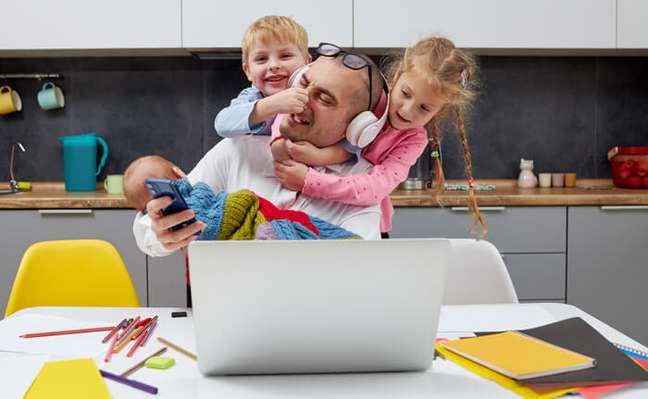Companies and employees have realized that neither extreme is productive.

I have participated in advertising organizations since the early 90s: Fenapro, Sinapros, APP Brasil, Abap, among others. I have since lectured on management in several states. In 2011, I launched my first book, Small Agencies, Big Results, which focused on advertising management.
In the lessons I have always dealt with the topic of the home office and flexible working hours.
For a long time no one shared the idea. Or because it is an underdeveloped theme, due to inefficient technology or even, what I believe more, due to the Brazilian culture of the old saying “It is the eye of the master that fattens the ox”.
In my second book, “I opened my agency, and now what?”, released at the beginning of 2013, I wrote two pages on the subject, which I transcribe here:
🇧🇷[…] Those who start with an operating concept totally different from the current one, which favors speed in delivery, reducing timescales and eliminating the steps between the briefing and placement, will do well. Revolutionizing with teams working from home, for example. Home office. Why not? What do most people in the office do? More than half of the time they are in front of a computer answering emails, WhatsApp, checking information, filling out spreadsheets or reports, answering the phone, etc. Nothing you can’t make at home.
Today, with so much technology, there is no justification for expecting an employee to spend almost three hours a day in traffic, in the case of São Paulo, to get to the office and then back home. Large multinationals have been operating remotely for many years, as it would be impossible to bring together teams that are so far apart. In countries like the US, working from home is already common. Today it is possible to make conference calls even through the mobile phone and every handset has a camera to interact with. Imagine the motivation of employees who can work from home? Productivity would increase.
For the company it is a great cost saving with space and indirect expenses such as meal vouchers, transport vouchers, overtime and also the possibility of paying even a lower salary, given that the employee will also have lower costs and less usury. .
Fear? Why not start slowly? Two days a week, for example. Over time, it will become clear that there is no need to worry. Customer visits? It’s just being objective and trying to work it out without attending body meetings. The essential will probably not happen more than once a week. Exaggerating, twice a week. In this case, the employee can go directly to the customer from home.
Is it possible that there is dispersion in working from home? That possibility exists, but no more so than in the office. Or does everyone think that just because they’re in the office, employees are working non-stop all day? Another thing that can help a lot and that few companies dare to do is flexible working hours. Can you imagine the employee choosing, from a schedule set by the company, what suits him best?
What is really needed is to break the paradigms. We are used to checking if everyone is in the company, if they have timed out, etc. It can no longer be like this. Also for the reasons set out below, with which it is clear that new hires no longer want to work in this type of structure.
Indeed, what matters to the company is productivity and its quality. If a team can do half a day of quality work, why keep it in the office all day on days when there’s nothing else to do?
Home office in rotational format
In fact, my idea of the home office was a rotating format, so that everyone participated, but at the same time between 40 and 50% of the teams were always at the company headquarters.
In March 2020 I had two scares. The first due to the pandemic and the other due to the lockdown and companies returning to headquarters and loving the idea of having the company only “in the clouds”.
At that time, I attended several lives, being perhaps the only one who definitely didn’t agree with 100% of the people at home, even though I understood that at that moment it was the only option.
I had and still have two discussions. The first was the loss of everything invested in companies related to culture, integration, values, strengthening personal relationships between employees and especially between bosses and subordinates, among others. And the second, no less important, was the mental health of the employees. He argued that we are not made to work 10/12 hours a day in front of a wall with children running around, maids cleaning the house, a dog, a parrot, a parakeet, etc.
He also argued that one situation was a house on the farm or on the beach, for those with better purchasing power, and another was working in a tiny apartment with the wife or children in the same room or even the bedroom. read.
To my delight, today I see the commercial rental market picking up again, restaurants full at lunchtime, heavy traffic at peak hours.
Companies and employees have realized that neither extreme is productive.
Common sense is prevailing and, it seems, should continue with a good deal of flexibility in schedules and twice-weekly home office for the most part.
This reminds me of a 1985 film directed by Ivan Cardoso and John Hebert, whose title was “The good times are back – Let’s enjoy it again”.
Antônio Lino Pinto (antonio.lino@viramundoconsultoria.com.br) is a management consultant and author of the books “Small agencies, great results” (2011), “I opened my agency, and now?” (2013), “Management in advertising agencies” (2017) and “Management for entrepreneurs” (2022).🇧🇷
The best content in your email for free. Choose your favorite Terra newsletter. Click here!
Source: Terra
Camila Luna is a writer at Gossipify, where she covers the latest movies and television series. With a passion for all things entertainment, Camila brings her unique perspective to her writing and offers readers an inside look at the industry. Camila is a graduate from the University of California, Los Angeles (UCLA) with a degree in English and is also a avid movie watcher.





